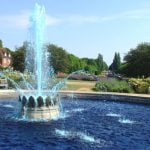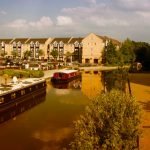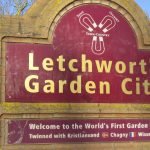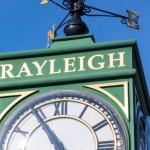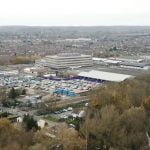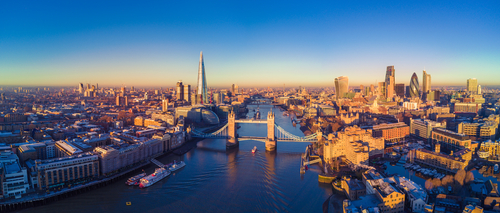
A quick guide to the City of London
Overview
The ‘City of London’ is a city and local government district that contains the historic centre and the primary central business district (CBD) of London. The City of London is more often referred to as ‘the City’ and differentiated from the phrase “the city of London” by capitalising the word ‘City’. The ‘City’ is now only a very small part of the great metropolis of London but represents a significant part of central London. It is one of the 33 local authority districts of Greater London but is the only one that is not designated with London borough status. An enclave of Greater London, it is recognised as a separate ceremonial county, the smallest in the United Kingdom. Colloquially, the City is also known as the ‘Square Mile’, as that is the approximate area that it covers, 1.12 sq miles to be precise. Both terms are often used as metonyms for the United Kingdom’s trading and financial services industries, which have a long history of largely being based in the City. In the 2011 UK Census, the resident population of the City was recorded as 7,375, although this swells to more 300,000 during a normal working day when commuters converge on the Square Mile to attend work. Most workers are employed in either the financial or legal professions or the associated business services sectors.
A Very Brief History
The Romans established a settlement on the current site of the City of London around AD 43, which was called ‘Londinium’. They built a bridge across the River Thames around AD 50, close to today’s London Bridge. Londinium was turned into a major port, serving as a major commercial centre for Roman Britain until its abandonment during the 5th century. At its height, the city had a population of between 45,000–60,000 inhabitants. Between AD 190 and 225, the Romans built a defence wall around the city, which became known locally as the London Wall. The boundaries of the Roman wall were similar to those of the City of London today, though the City extends a little further west than Londonium’s Ludgate.
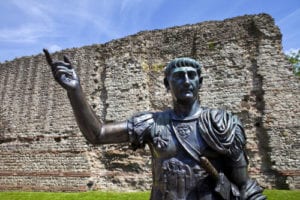
Roman Emperor Trajan in front of the London Wall
By the time the London Wall was finished construction, the Anglo Roman Empire was already in serious decline. Londinium came under attack from the Picts, Scots and Saxons and in AD 410 the Romans withdrew entirely from Britain. By this time, many of the Roman public buildings in Londinium had fallen into decay and disuse, which prompted a gradual withdrawal from the city, and it became largely uninhabited. The focus now moved westwards to the Anglo Saxon settlement of Ludenwic (London market), which roughly occupies the modern-day Strand/Aldwych/Covent Garden area.
It wasn’t until 886, that resettlement of the old Roman walled city of Londinium took place. It was part of a campaign by Alfred the Great, King of Wessex to retake the Viking occupied parts of England. The re-fortified Anglo-Saxon settlement was known as Lundenburh (London Fort). Alfred’s restoration entailed re-occupying and refurbishing the near-deserted former Roman city, building quays along the Thames and adopting a new city street plan.
Alfred’s taking and rebuilding of the old walled city was a significant turning point in English history, as it signalled both the permanent establishment of the City of London and that of the Kingdom of England. Arguably, it also established Alfred as the first King of England, who with some degree of success fended off further Viking raids and occupation. With the City of London and the Kingdom of England now established, the focus of trade and population moved back to within the old Roman walls. Somewhat ironically, the old Saxon settlement of Lundenwic was now largely abandoned and renamed Ealdwic (the ‘old settlement’). The name survives today as Aldwych (the ‘old market-place’), a street name and area between Westminster and the City of London.
Following the Battle of Hastings in 1066, William the Conqueror marched on London but failed to cross London Bridge and defeat the City of London. In 1075, William granted the citizens of London a charter, one of the few English townships to retain some authority. Furthermore, as a measure of its autonomy, London was not included in the census that led to the drafting of the Domesday Book. Around 1130, Henry I appointed a sheriff to look after the interests of the people of London. By 1189, citizens gained the right to appoint a mayor, and by 1215 to directly elect the mayor.
During medieval times, the City was divided into 25 wards, for electoral and administrative reasons. Each ward was headed by an alderman, who chaired Wardmotes, which still take place today on an annual basis. Many of the City’s medieval offices and traditions continue to the present day.
In 1381, the Peasants’ Revolt affected London. The rebels took the City and the Tower of London, but the rebellion ended after its leader, Wat Tyler, was killed during a confrontation with the Lord Mayor, William Walworth.
By the late 16th century, London was becoming increasingly recognised as a major centre for banking, international trade and commerce. In 1565, the Royal Exchange was founded by Sir Thomas Gresham as a centre of commerce for the city’s merchants. In 1665, the Great Plague (aka the Black Death) wiped out up to an estimated 30% of the population. The Great Fire of the London of the following year devastated the city, resulting in large swathes having to be rebuilt.
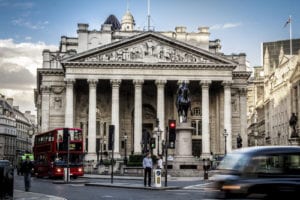
The Royal Exchange building in the City of London
In 1691, Lloyd’s Coffee House was established on Lombard Street, which became the world-leading insurance market. Today, the insurance industry is still largely based in that area. In 1734, the Bank of England moved to its present site, opposite the Royal Exchange on Threadneedle Street.
In 1708, Christopher Wren’s masterpiece, St Paul’s Cathedral, was completed, although the first service had been held there more than 10 years earlier. It replaced the original St Paul’s, which had been completely destroyed in the Great Fire of London.
The 18th century was a period of rapid growth for London, reflecting an increasing national population, largely driven by the Industrial Revolution and London’s role at the centre of the evolving British Empire. The urban area began to expand beyond the borders of the City of London, most notably towards the West End and Westminster.
At the beginning of the 19th century, London was growing in all directions at an accelerated pace. In the East, the Port of London grew rapidly with the expansion of the docklands, which was needed to cope with the growing volumes of trade. The arrival of the railways and Underground was the impetus for London to expand even more in terms of both population and area. By the mid-19th century, the City was already only a very small part of a much greater metropolis.
In 1885, the Redistribution of Seats Act saw the City’s MP representation cut from 4 to 2. And in 1894, the Royal Commission proposed to end the distinction between the City and the surrounding County of London. However, a change of government enabled the City to survive as a distinct polity, despite numerous local government reforms. By the end of the 19th century, the City’s population had fallen dramatically. The trend continued through most of the 20th century, as people moved outwards to London’s vast suburbs. Former residential buildings were demolished to make way for office blocks. This was particularly true after WW2 since large swathes of the City had fell victim to destructive aerial bombing from the Luftwaffe. In 1948, the Representation of the People Act, saw the City lose its status as a separate constituency given that both its physical area and population no longer fit the required criteria.
The 1970s saw the City become home to the UK’s first skyscraper, the Natwest Tower. Since then, skyscrapers have become commonplace within the City, some of the tallest and most notable include 30 St. Mary Axe (“the Gherkin”‘), Leadenhall Building (“the Cheesegrater”), 20 Fenchurch Street (“the Walkie-Talkie”), the Broadgate Tower and the Heron Tower.
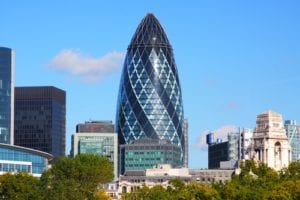
The ‘Gherkin’ Tower building in the City of London
Did you know?
- There are over 500 banks in the City of London, most of them foreign. It has more Japanese banks than Tokyo and more American banks than Manhattan
- The City of London is the centre of global foreign exchange dealing. Over 40% of all the world’s foreign exchange transactions are made in the City – a total of $2.7 trillion per day!
- There are more international telephone calls made from the City of London on a typical working day than from any other city in the world
- The City of London has a unique political status, a legacy of its uninterrupted integrity as a corporate city since Anglo-Saxon times
Getting Around!
On foot!
The easiest way to get around the City itself is on foot. Its small and compact nature means tourist attractions are all within a short walk of each other. If you’re new to the City its best to buy a detailed map or pick up a free one from the City Information Centre as its quite easy to get lost.
Train
The following train stations can be found in the City:
- Barbican
- Blackfriars (for Gatwick and Luton airports)
- Cannon Street
- City Thameslink (for Gatwick and Luton airports)
- Fenchurch Street
- Liverpool Street (for Stansted Airport)
- Moorgate
Underground (Tube)
Six of the eleven underground lines pass through the City calling at the following stations:
- Barbican
- Moorgate
- Liverpool Street
- Old Street
- St Paul’s
- Blackfriars
- Mansion House
- Cannon Street
- Tower Hill
- AldgateBy boat
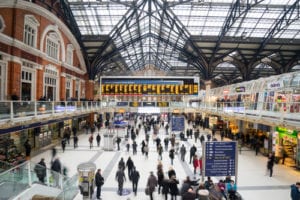
Liverpool Street Station in the City Of London
Boat
The City has two piers from which regular boat services operate on the Thames:
- Blackfriars Millennium Pier (in the west)
- Tower Millennium Pier (in the east)
Things to see and do!
The City of London is home or very close to some of the Capital’s best-rated attractions, which include:
Tower Bridge
The Monument
Tower of London
St Paul’s Cathedral
Barbican Centre (home of the London Symphony Orchestra)
The Royal Exchange
Museum of London
Bank of England Museum
Guildhall Art Gallery
Guildhall Library
Mansion House
Bishopsgate Institute
Dr Johnson’s House
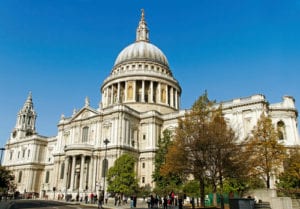
The iconic St Paul’s Cathedral in the City of London
Where to stay?
If you want to stay with the City Of London itself, it’s probably going to be relatively expensive as budget accommodation is very limited. You will probably be able to find cheaper accommodation in nearby Tower Hamlets, Camden or Islington. Indicative prices for the most readily available types of accommodation/per night, based on 2 adults sharing are as follows:
3/4/5 Star Hotel: £200 – £450
Apartments vary greatly based on no. of available berths, location and standard
If you enjoyed this guide, be sure to check out our other London guides by clicking the link below.
